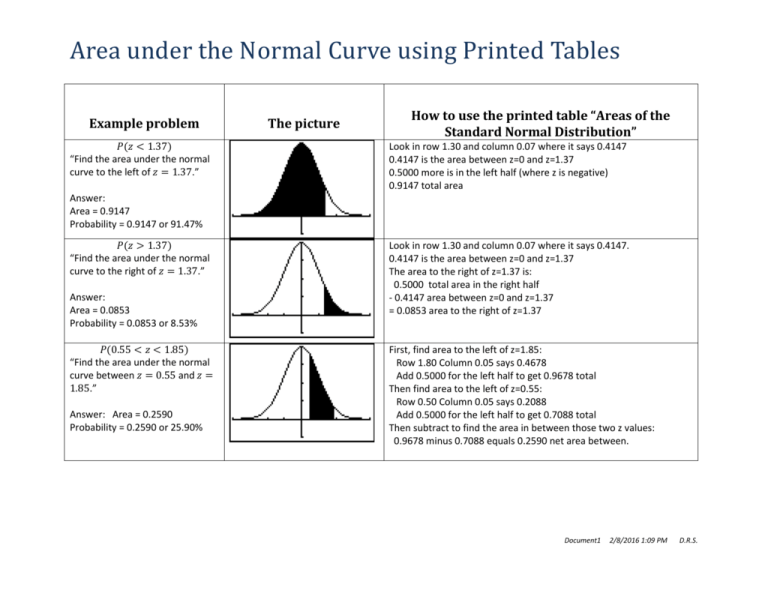PrintedTable_PositiveZOnly
advertisement

Area under the Normal Curve using Printed Tables Example problem 𝑃(𝑧 < 1.37) “Find the area under the normal curve to the left of 𝑧 = 1.37.” The picture How to use the printed table “Areas of the Standard Normal Distribution” Look in row 1.30 and column 0.07 where it says 0.4147 0.4147 is the area between z=0 and z=1.37 0.5000 more is in the left half (where z is negative) 0.9147 total area Answer: Area = 0.9147 Probability = 0.9147 or 91.47% 𝑃(𝑧 > 1.37) “Find the area under the normal curve to the right of 𝑧 = 1.37.” Answer: Area = 0.0853 Probability = 0.0853 or 8.53% 𝑃(0.55 < 𝑧 < 1.85) “Find the area under the normal curve between 𝑧 = 0.55 and 𝑧 = 1.85.” Answer: Area = 0.2590 Probability = 0.2590 or 25.90% Look in row 1.30 and column 0.07 where it says 0.4147. 0.4147 is the area between z=0 and z=1.37 The area to the right of z=1.37 is: 0.5000 total area in the right half - 0.4147 area between z=0 and z=1.37 = 0.0853 area to the right of z=1.37 First, find area to the left of z=1.85: Row 1.80 Column 0.05 says 0.4678 Add 0.5000 for the left half to get 0.9678 total Then find area to the left of z=0.55: Row 0.50 Column 0.05 says 0.2088 Add 0.5000 for the left half to get 0.7088 total Then subtract to find the area in between those two z values: 0.9678 minus 0.7088 equals 0.2590 net area between. Document1 2/8/2016 1:09 PM D.R.S. Example problem “Find the total area under the normal curve.” The picture How to use the printed table “Areas of the Standard Normal Distribution” No table is needed. This is fact that you simply have to know. You should know this very basic special fact, that the total area under a probability distribution is always exactly precisely = 1. “What is the area under the right half of the normal curve?” and “What is the area under the left half of the normal curve?” No table is needed. These are facts that you simply have to know. You should know these very special facts about the Normal Distribution: it is symmetric, 𝑧 = 0 is in the middle, half of the area (0.5) is to the left and half of the area (0.5) is to the right. Document1 2/8/2016 1:09 PM D.R.S. Example problem The picture How to use the printed table “Areas of the Standard Normal Distribution” 𝑃(𝑧 < −2.02) “Find the area under the normal curve to the left of 𝑧 = −2.02. The table only has positive z-values. Because of symmetry, the area to the left of z=-2.02 Is the same as the area to the right of z=+2.02. Answer: Area = 0.0217 Probability = 0.0217 or 2.17% Look in row 2.00 column 0.02 to find 0.4783. Area between z=0 and z=2.02 (positive) is 0.4783. Therefore area to the right of z=+2.02 (positive) is 0.5000 minus 0.4783 equals 0.0217. The table has only positive z-values. Because of symmetry, the area between z=0 and z=+2.02 Is the same as the area between z=-2.02 and z=0. 𝑃(𝑧 > −2.02) “Find the area under the normal curve to the right of 𝑧 = −2.02.” Answer: Area = 0.9783 Probability = 0.9783 or 97.83% Look in row 2.00 column 0.02 to find 0.4783. The total area between z=-2.02 and z=0 is 0.4783. Add 0.5000 for the right half of the area = 0.9783 total. 𝑃(−1.38 < 𝑧 < −0.38) “Find the area under the normal curve between 𝑧 = −1.38 and 𝑧 = −0.38.” Because of symmetry, the area between z=-1.38 and z=-0.38 Is the same as the area between z=+0.38 and z=+1.38. Answer: Area = 0.2682 Probability = 0.2682 or 26.82% 𝑃(−1.79 < 𝑧 < 2.20) “Find the area under the normal curve between 𝑧 = −1.79 and 𝑧 = 2.20.” Answer: Area = 0.9494 Probability = 0.9494 or 94.94% Look in row 1.30 column 0.08 to find 0.4162. Look in row 0.30 column 0.08 to find 0.1480. Subtract 0.4162 minus 0.1480 to get area 0.2682. Or, if you added the 0.5000 to each, 0.9162 minus 0.6480 = 0.2682, the same answer again. The right half: Look in row 2.20 column 0.000 to find 0.4861. The left half: Because of symmetry, the area between z=-1.79 and z=0 is the same as the area between z=0 and z=+1.79. Look in row 1.70 column 0.09 to find 0.4633. Add 0.4861 plus 0.4633 = total area 0.9494 Document1 2/8/2016 1:09 PM D.R.S. Example problem The picture What z-scores bound the middle 50% of the area? How to use the printed table “Areas of the Standard Normal Distribution” Look in the body of the table to find the value closest to 0.2500. It is 0.2486. Read outward to see you’re in row 0.60 column 0.07, So the z-score is 0.67. Think and draw: 50% = 0.5000 shaded in middle By symmetry, the other end is at z=-0.67. 0.5000 divided by 2 = 0.2500 Answer: 𝑧 = −0.67 to 𝑧 = 0.67 What z-scores bound the middle 68% of the area? Look in the body of the table to find the value closest to 0.3400. It is 0.3389. Read outward to see you’re in row 0.90 column 0.09. So the z-score is 0.99 Think and draw: 68% = 0.6800 shaded in middle By symmetry, the other end is at z=-0.99. 0.6800 divided by 2 is 0.3400 Answer: 𝑧 = −0.99 to 𝑧 = 0.99 This is why the Empirical Rule says “In a Normal Distribution, about 68% of the data lies within 1 standard deviation of the mean.” Document1 2/8/2016 1:09 PM D.R.S. Example problem The picture What z-scores bound the middle 95% of the area? How to use the printed table “Areas of the Standard Normal Distribution” Look in the body of the table to find the value closest to 0.4750. It is in the table, this is unusual! Think and draw: 95% = 0.9500 shaded in middle Read outward to see you’re in row 1.90 column 0.06. So the z-score is 1.96 0.9500 divided by 2 is 0.4750 By symmetry, the other end is at z=-1.96. Answer: 𝑧 = −1.96 to 𝑧 = 1.96 This is why the Empirical Rule says “In a Normal Distribution, about 95% of the data lies within 2 standard deviations of the mean.” What z-scores bound the middle 99.7% of the area? Look in the body of the table to find the value closest to 0.4985. It is in the table twice. That happens with the extreme tails of the normal distribution. Think and draw: 99.7% = 0.9970 Read outward to see you’re in row 2.90 column 0.06 or column 0.07. So the z-score is 2.96 or 2.97 0.9970 divided by 2 is 0.4985 Answer: 𝑧 = −2.97 to 𝑧 = 2.97 This is why the Empirical Rule says “In a Normal Distribution, about 95% of the data lies within 2 standard deviations of the mean.” By symmetry, the other end is at z=-2.96 or z=-2.97 It turns out that with the help of computers or calculators we can determine that the 2.97 version is really more accurate. Document1 2/8/2016 1:09 PM D.R.S. Example problem What z-score separates the top 10% of the data from the bottom 90%? Think and draw: 90% = 0.9000 area is to the left. 10% = 0.1000 area is to the right The picture How to use the printed table “Areas of the Standard Normal Distribution” The table gives areas in the right half. The total area to the left is 0.9000. Subtract the 0.5000 left half to get 0.4000 area in the right half. Look in the body of the table to find the value closest to 0.4000. It is 0.3997. Read outward to see you’re in row 1.20 column 0.08. Answer: 𝑧 = 1.28 What score separates the bottom third of the data from the top two-thirds? Think and draw: 1/3 to the left. You can use the fraction in TI-84 or in Excel. Answer: 𝑧 = −0.43 The z-score of interest is therefore 1.28 By symmetry, the z-score that separates the bottom 1/3 of the area is the negative of the z-score that separates the top 1/3 of the area. In the right half, we want the z-score that separates 0.1667 of the area to the left from the 0.3333 of the area to the right. Look in the body of the table to find the value closest to 0.1667. It is 0.1664. Read out to find you’re in row 0.40 column 0.03. Therefore the z-value is 0.43. But we want the mirror image of that, so our z-score is -0.43. Document1 2/8/2016 1:09 PM D.R.S.







